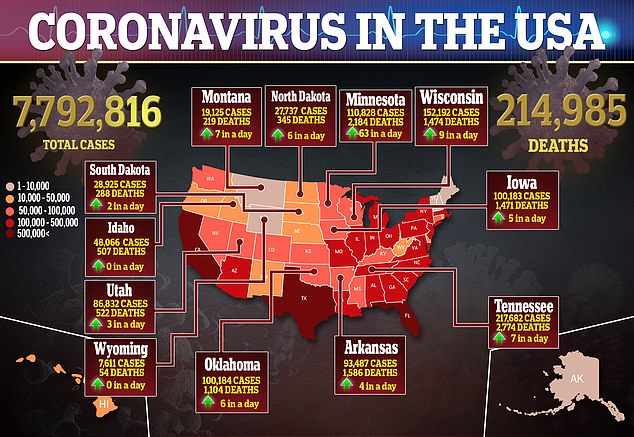A majority of Americans believe unproven or debunked claims and viral conspiracies, according to a joint survey by the liberal think tank, the Center for American Progress, and the right-leaning American Enterprise Institute.
The survey tested different conspiracy theories — on politics, science and public health — to gauge whether demographic or partisan backgrounds are correlated to a higher likelihood of accepting or rejecting certain claims.
Misinformation about Covid-19 is most pronounced among Republicans, with 48% believing that the disease is no more dangerous than the flu and 42% saying that hydroxychloroquine — an anti-malaria drug championed by President Trump despite scientific misgivings — is a safe and effective treatment for the virus, survey data shows.
One of the biggest new conspiracy theories is that 5G networks spread the coronavirus.
It is biologically impossible for viruses to spread using the electromagnetic spectrum.
The latter are waves or photons, while the former are biological particles composed of proteins and nucleic acids.
But that hasn’t stopped the enormous amount of misinformation on social media.
COVID-19 was also not unleashed by billionaire Bill Gates.
Sixty percent of Democrats believe Russia has compromising information about Trump, while roughly the same percentage of Republicans are convinced there has been a coordinated effort by “unelected government officials” to undermine the Trump administration.
Less than half of those surveyed, 44%, said they would be willing to get a no-cost, FDA-approved vaccine to prevent Covid-19, a finding roughly equal among Democrats (47%) and Republicans (45%).
However, only 21% of Black Americans report that they would take it, the survey found.
An emboldened community of believers known as QAnon is spreading a baseless patchwork of conspiracy theories that are fooling Americans who are looking for simple answers in a time of intense political polarization, social isolation and economic turmoil.
Experts call QAnon a “digital cult” because of its pseudo-religious qualities and an extreme belief system that enthrones Trump as a savior figure crusading against evil.
The core of QAnon is the false theory that Trump was elected to root out a secret child-sex trafficking ring run by Satanic, cannibalistic Democratic politicians and celebrities.
Although it may sound absurd, it has nonetheless attracted devoted followers who have begun to perpetuate other theories that they suggest, imply or argue are somehow related to the main premise.
While many QAnon theories and content remain on fringe platforms like far-right message board 8kun, some have made their way into mainstream social media services like Facebook, Twitter and YouTube.
On those platforms, the bogus or misleading material is gaining traction among people who have no idea they’re dabbling in QAnon.
The survey’s findings underscore the indiscriminate impact of false or misleading information running rampant ahead of a contentious national election.
The study also revealed a broad distrust of the government, drug companies, technology companies and news organizations.
“American society faces a genuine crisis in public trust in government, corporations and the media, exacerbated by wide partisan divides about who and what to believe,” said John Halpin, a senior fellow at the Center for American Progress and co-author of the report, in a statement.
Despite heated national debate surrounding voter fraud, confidence in the voting process for the upcoming Nov. 3 election was relatively strong with 60% of Americans saying it would be administered “very well” or “somewhat well.”
However, the issue of mail-in voting exposed stark partisan differences.
Almost 80% of Republicans believe that increased mail-in voting will result in widespread fraud versus 79% of Democrats who disagree.
“If we can’t agree on basic facts about what is going on in our country, there is little hope of generating consensus on what needs to be done to control the pandemic and fix our economy,” Halpin said. “Rebuilding public trust in major institutions, and the information they provide the public, is now a national priority.”
With trust in governments and the media is at an all-time low, there are plenty of conspiracy theorists who’d want to rise and push their own agenda for the susceptible population.
And the only thing science can’t do is to fight fire with fire, because science deals only in fact.
Why are we so susceptible to conspiracy theories?
Multiple factors and motives—among them economic, historical, and sociological—are involved.
Yet as always when it comes to us humans, psychology too plays a major role.
Psychological research has uncovered several mechanisms underlying our perpetual penchant for purveying preposterous plots.
Here are a few central ones:
First is the fundamental attribution error, which is our tendency to prefer dispositional explanations to situational ones.
When we observe an event happening, we are much more likely to attribute it to some intentional, internal motive than to circumstance and happenstance.
Conspiracy theories are by definition dispositional—someone planned this for a purpose.
They are thus uniquely satisfying to our minds.
Australian philosopher Steve Clarke writes: “As explanations, conspiracy theories are highly dispositional. When conspiracies occur it is because conspirators intend them to occur and act on their intentions … In most cases, the received view, the conventionally accepted nonconspiratorial alternative to a particular conspiracy theory, is a situational explanation.”
Second is confirmation bias and its brother, the belief perseverance phenomenon—two well-known aspects of our cognitive hardware.
Confirmation bias refers to the fact that we tend to become attached to our beliefs and to search for (or interpret) information in ways that confirms our preconceptions.
Once we settle on a conviction, we will search, remember, and accept only evidence that supports it, while ignoring and neglecting to seek disconfirming evidence.
This is why people online gravitate to sites that echo their preexisting beliefs and prejudices.
Belief perseverance refers to the fact that we seek to maintain our beliefs even after the information that originally gave rise to it has been refuted.
Once we’re set in our beliefs, evidence to the contrary will be dismissed, actively.
This is why politicians promote polls that show them to be popular (confirmation bias) and label as “fake” those polls that don’t (belief perseverance).
This is why when you’re in love, you tend to latch onto everything good about your love object and gloss over or fail to notice warning signs (confirmation bias).
When your friends warn you about the love object, you accuse them of lying out of jealousy (belief perseverance).
Thus, ironically, once we settle on a belief, however deluded or implausible (e.g., the earth is flat), we’re highly likely to seek and believe information that supports it (“looks flat to me!”) while rejecting any data to the contrary, however plausible, as false, malevolent, or deluded (“The science? All the scientists are lying”).
A third psychological factor is our desire to be uniquely knowledgeable, to possess knowledge that others don’t.
Knowledge is power.
And we all prefer feeling powerful to feeling powerless.
This is gratifying and empowering for us particularly when the complexity and uncertainty of life feels overwhelming.
“Conspiracy theories … supply a seductive ego boost. Believers often consider themselves part of a select in-group that — unlike the deluded masses — has figured out what’s really going on.”
Fourth is our brain’s adaptive capacity for pattern recognition.
As Johns Hopkins neurologist Mark Mattson puts it: “Superior pattern processing is the essence of the evolved human brain.”
It is, “the fundamental basis of most, if not all, unique features of the human brain including intelligence, language, imagination, invention, and the belief in imaginary entities such as ghosts and gods.”
Indeed, our brain has evolved in a dangerous environment where the ability to “fill in the blanks,” to guess the whole from a few parts, conferred important survival advantages.
If I can make out from a distance the hidden predator in the bushes, I’m more likely to survive.
Thus our brain came to specialize in meaning-making and pattern-finding.
In extreme form, this tendency is known as Pareidolia.
While entertaining at times, as when we see a face on the moon and Jesus in a piece of burnt toast, this tendency has a shadow side, since in the absence of a pattern, our brain will tend to invent one and impose it on the world, as when we think that a flipped coin is ‘due’ to hit ‘heads’ after a string of ‘tails,’
Our brain seeks order, cause and effect, and intentionality.
But life is filled with chaos, blind chance, illusory correlations, and disorder.
When these conditions impinge on us we become distressed, and to reduce the distress, we are compelled to make stories that fit the demands of our brain, rather than the facts of the world; stories in which intentionality, order, coherence, and purpose exist, albeit in hidden form—e.g.: conspiracy.
As psychologists Jan-Willem van Prooijen and Karen Douglas conclude in their review of the literature: “Evidence suggests that the aversive feelings that people experience when in crisis—fear, uncertainty, and the feeling of being out of control—stimulate a motivation to make sense of the situation, increasing the likelihood of perceiving conspiracies in social situations.”
Interestingly, the pattern recognition capability that gives rise to conspiracy theorizing also lies at the root of another defining feature of humanity—religion.
Conspiracy theories are quite analogous to religion in that, “their contents, forms, and functions parallel those found in beliefs of institutionalized religions.”
Like religions, conspiracy theories tend to assume a powerful, unseen force that is responsible for those things that happen but defy explanation.
Like religions, conspiracy theories tend to ascribe power to an entity that is hidden yet active in the world, that is more powerful than us, but not entirely unlike us psychologically (God rages; God forgives).
As with religion, conspiracy believers are uniquely reluctant to be swayed by argument.
As law professors Cass Sunstein (University of Chicago) and Adrian Vermeule (Harvard) note: “A distinctive feature of conspiracy theories is their self-sealing quality. Conspiracy theorists are not likely to be persuaded by an attempt to dispel their theories; they may even characterize that very attempt as further proof of the conspiracy.”
Finally, like religions, conspiracy theories are, at the core, about community, manifesting our most fundamental tribal impulse—the psychological need to belong, to be part of a well-defined in-group and, by extension, to recognize and fight enemy out-groups.
Like religions, conspiracy theories are group phenomena, shared by communication rituals that help adherents manage emotions by, “transforming unspecific anxieties into focused fears.”
As in religion, successful (enduring) conspiracy theories produce narratives that are “framed as conflicts over sacred values.”
With religion, the false God is never our God.
With the conspiracy theory, the menacing shadowy group is never our group.
Conspiracy theories are always about ‘the other.’
As psychologist Jan-Willem van Prooijen notes: “the root of conspiracy thinking lies in our ancient instinct to divide the social world into ‘Us’ and ‘Them’ categories.”
The same psychological processes that produce God for ‘us,’ produce conspiracy theories about ‘them.’
Our basic psychological structure has remained largely unchanged for as long as we can tell.
To wit, ancient biblical stories, not to mention centuries-old Shakespearean plays, speak to us now because the characters in them–their tendencies, fears, struggles, and desires—resemble us greatly.
As long as our basic psychology remains unchanged, conspiracy theories will continue to flourish as by-products of the evolved processes of our mind.
Source: Psychology Today

